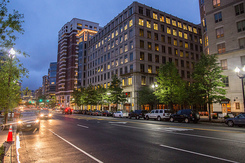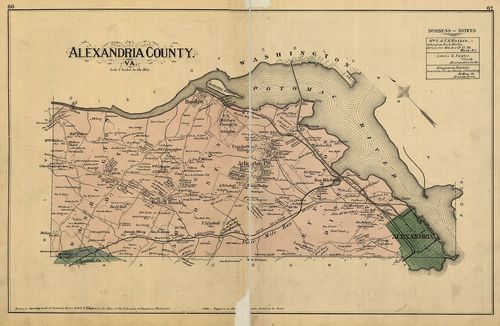Ask GGW: How do Arlington and Alexandria differ?
Arlington and Alexandria. They’re, like, the same place… right? Ok yeah, no, they aren’t. But one of our readers did point out that to many, two of DC’s southern neighbors often get mistaken for one another, so we’ve explained a number of the differences.


Left: Wilson Boulevard in Arlington. Photo by Tony Webster on Flickr. Right: Old Town Alexandria. Photo by Roger W on Flickr.
The reader asks:
My fiancée and I currently live in Arlington, where we rent a high-rise apartment in Crystal City. We’ll soon be moving to Alexandria, where we will be renting a townhouse in Old Town. It seems like a lot of people who live in DC or Maryland think that Arlington and Alexandria are the same place. I know that they’re distinct jurisdictions but I’ll admit, they’re similar enough that I’m not clear on the differences. So as a transit-oriented urbanist making the move, what should I know about differences in local law, Alexandria local politics, reliability of public transit, and so on?
First, some history
Virginia donated both “Old Town” Alexandria and the land that later became Arlington County to form the District of Columbia in 1801. At the time, Congress organized the area as a subdivision of DC and named it Alexandria County.
In 1846, the land went back into Virginia’s possession when DC was downsized to exclude the portion south of the Potomac River. In 1852, what was then the Town of Alexandria incorporated as a city; it became independent of Alexandria County in 1870.
Since 1871, all municipalities in Virginia incorporated as “cities” have been “independent cities,” not politically part of a county. This revision to the state constitution happened after the Civil War and the creation of West Virginia.
In 1908, the Town of Potomac incorporated as a town in Alexandria County. To avoid confusion with the adjacent city, Virginia’s General Assembly changed the name of Alexandria County to Arlington County in 1920. The City of Alexandria annexed the Town of Potomac in 1930, and it’s now designated as the Town of Potomac Historic District.
A number of neighborhoods in Fairfax County that aren’t in Alexandria’s city limits, like Franconia, Groveton, Huntington, Hybla Valley, Kingstowne, and Mount Vernon, still use the namesake on their postal addresses.
The local laws and politics are different…
Aimee Custis points out that since Arlington is a county, it’s governed by a County Board. Alexandria, on the other hand, is governed by a City Council.
Canaan Merchant mentions that “Arlington was actually very rural for a long time and its current level of development didn’t really take off in earnest until the mid and late 20th century. That informs how both areas look. Alexandria has great examples of ‘old urbanism’ while Arlington showcases how it’s done today without worrying about historic preservation so much.”
Kevin Beekman shares some details:
Alexandria and Arlington share so little in terms of administration, policing and planning for such relatively small jurisdictions. That has only recently begun to change. The development of Potomac Yard caused a dilemma for both jurisdictions because the county/city border was not changed with the realignment of Four Mile Run during the flood control project of the 1970-80s. This forced them to work together and resulted in the joint Four Mile Run Restoration Plan than is now underway.
I think the main difference is that Arlington was almost all developed since the start of World War II and was largely rural before that, whereas Alexandria (even the parts it annexed from Arlington) predate that at least somewhat. The big exception is the West End that Alexandria annexed from Fairfax County. The City and County allow residents to share public libraries though. I’ve found that useful.
As for differences in local laws, one that comes to mind is that new residents will only have 30 days to apply for a city decal showing that they’ve paid personal property tax in Alexandria on a percentage of the value of the car.
Agnès Artemel gives us a great in-depth analysis on the differences between Arlington and Alexandria, from the perspective of being a long-time Alexandria resident:
Alexandria and Arlington should be very similar in that they are both “inside the Beltway” communities that were once dependent on DC to employ their residents but now have developed their own employment centers.
But, as a long-time Alexandria resident, I feel they are very different — in physical appearance, way of life, and politics.
Physical: Alexandria has a very large grid-patterned Old Town that give it a distinct sense of place and a reason for tourism; the waterfront is another asset. Central Alexandria is all suburbia — large lot single-family. And the west is highway-oriented: apartments and condos for those who used I-395 to get to DC. To me, Arlington is divided up several ways 1) by the highways that traverse it making it seem impossible to get from place to place, and 2) by the Rosslyn-Ballston corridor versus the area to the north and the area to the south. Arlington also has huge federal land reservations that break it up. To Alexandrians, Arlington’s streets make no sense whatever — lacking connections and even a reasonable naming system.
Way of life: Alexandria is still the sleepy southern town. Residents don’t like bars and restaurants to stay open past 11 or 12. They don’t like outsiders, particularly commuters from Fairfax. They tried to get toll gates set up at entrances to the city to discourage commuters. We wish we could be an island away from this pesky growthy region. Arlington has seemed more dynamic, more interested in jobs, economic development, and the new economy based on tech. Arlington found a way to separate its growth areas (Rosslyn-Ballston, Crystal City) from the neighborhoods that want to be protected from tall buildings. Alexandria is still fighting land use battles one at a time, starting from scratch on each one.
Politics: Until recently, it felt like Arlington had figured out how to get buy-in on smart growth, and the Board appeared unified in its approach to land use. Alexandria kept missing opportunities due to fear of opposition— we could have had the Potomac Yard infill Metro station in the mid-80s, for example. And for a long time, driving on Jefferson Davis Highway it was quite clear where the jurisdictional boundary was— Alexandria got all the traffic and none of the tax revenues was the way we saw it. Arlington planned for a streetcar through Crystal City and Alexandria planned for a BRT, and people were going to have to switch at Four Mile Run (no one will get a streetcar now, so its a moot point today).
Of course, much has changed in the last couple of years, in both jurisdictions. Time will tell whether we become more similar or not, and whether that’s good or bad.
Jonathan Krall touches on similar points:
Alexandria and Arlington have commonalities, such as the streetcar suburbs of Del Ray (Alexandria) and Clarendon (Arlington), both developed by the same company in the late 1800s. A big difference is that Alexandria predates Washington DC and has attitudes shaped by its history.
One way of looking at it is that many of the “mover and shakers” in Alexandria still want it to be a sleepy southern town where no decision is made until the proper people are consulted. After a major fight over bike lanes on King Street, in 2013-2014, the Alexandria leadership took steps to avoid further fights, delaying two bicycle projects that were scheduled to begin planning for Old Town. Major projects, such as the waterfront plan, are accomplished only by overcoming that conservatism.
All that is by way of saying the Alexandria has a conservatism that has been largely missing in Arlington. However, the recent street car revolt in Arlington makes this difference less certain going forward. Both places talk a good game in terms of urbanism, but Arlington does a better job of following through with their new-urbanist ambitions. This is why, on Potomac Ave, the bike lanes stop at the Arlington/Alexandria border.
…and so is transportation
Aimee Custis points out that both jurisdictions are served by WMATA Metrorail and Metrobus, however Arlington’s local bus service is Arlington Transit (ART) and Alexandria’s service is DASH.
Canaan Merchant mentions that “Arlington has a bit more flexibility when it comes to its transportation decisions because they opted to maintain control of their own roads rather than have VDOT take over (that’s part of the reason why Arlington has more bike infrastructure).”
“Arlington doesn’t really have any waterfront areas despite having more land on the river. The GW Parkway, Arlington Cemetery, and Ronald Reagan Washington National Airport prevent the county from really developing one as well.”
With regards to bicycling, Jonathan Krall says that “On the plus side, Alexandria has a large, flat, street-grid area that is relatively easy for bicycling, despite a paucity of bike lanes. One can reach the metropolitan downtown from this area of town without going up or down a big hill. This is something that Alexandria has in common with Portland, OR, and may be responsible for Alexandria’s very good bicycle mode share.”
The conversation then shifted to Arlington and Alexandria’s street-naming system, with Michael Perkins giving some basic information about Arlington’s system:
There is actually a good naming system for Arlington, unlike the “system” in Old Town Alexandria. North-South streets have names and East-West streets have numbers. First set of streets have one-syllable names like Bell and Clark. Second set have two syllable names like Kenmore or Quincy. Third set have three syllable names like Somerset or Quintana. There’s only one four syllable name—Arizona.
There are longer boulevards and drives that don’t follow this pattern. Examples are Arlington Boulevard, Lee Highway, Washington Boulevard, Fairfax Drive, George Mason Drive, and Shirlington Road.
Jonathan Krall gives us the Alexandria perspective:
In Alexandria, the original main street was Cameron, flanked by parallel streets King to the south and Queen to the north. Next was Prince and Princess. Then Duke and Oronoco. Oronoco was named for a tobacco warehouse.
Kevin Beekman adds, “In Alexandria, street numbers increase as you go north. In Arlington, street numbers increase as you go south. So there are places on Jefferson Davis Highway were the addresses (or block numbers) repeat.”
Michael Perkins also adds that the street numbers in Arlington increase “as you get further away from Arlington Boulevard, either north or south”.
Do you have a question? We’ll pose it to the Greater Greater Washington contributors and post appropriate parts of the discussion. You can suggest questions by emailing ask@ggwash.org. Questions about factual topics are most likely to be chosen. Thanks!



